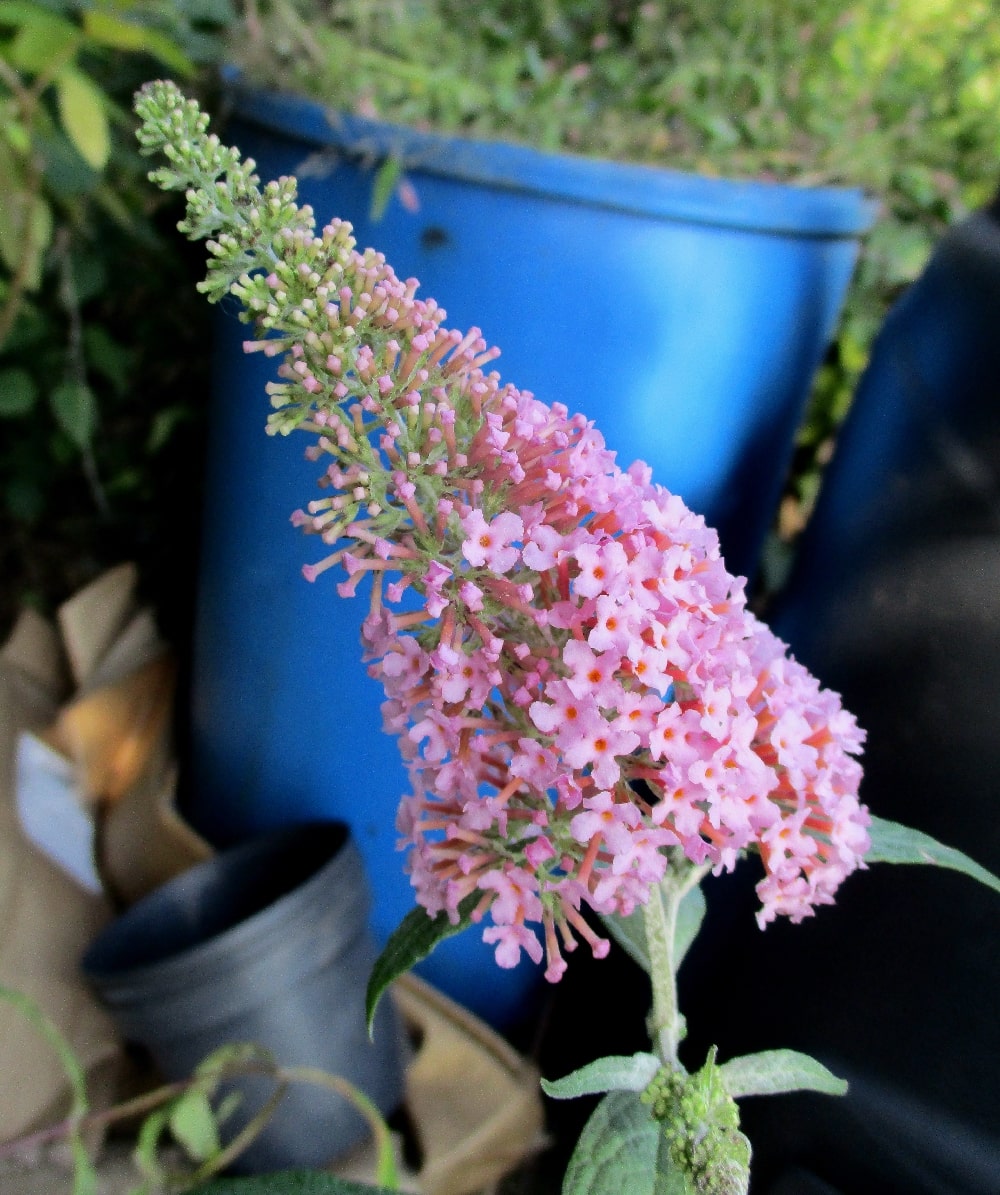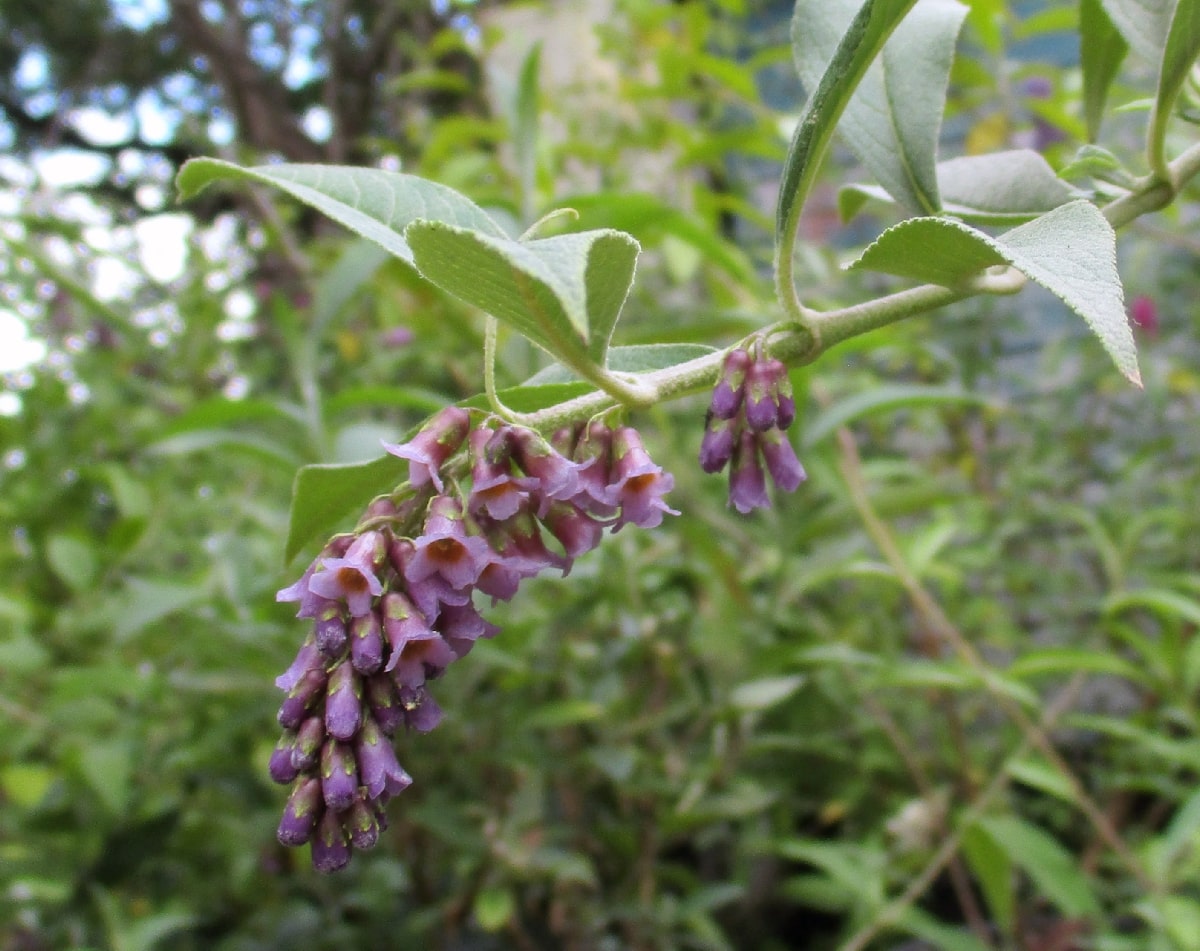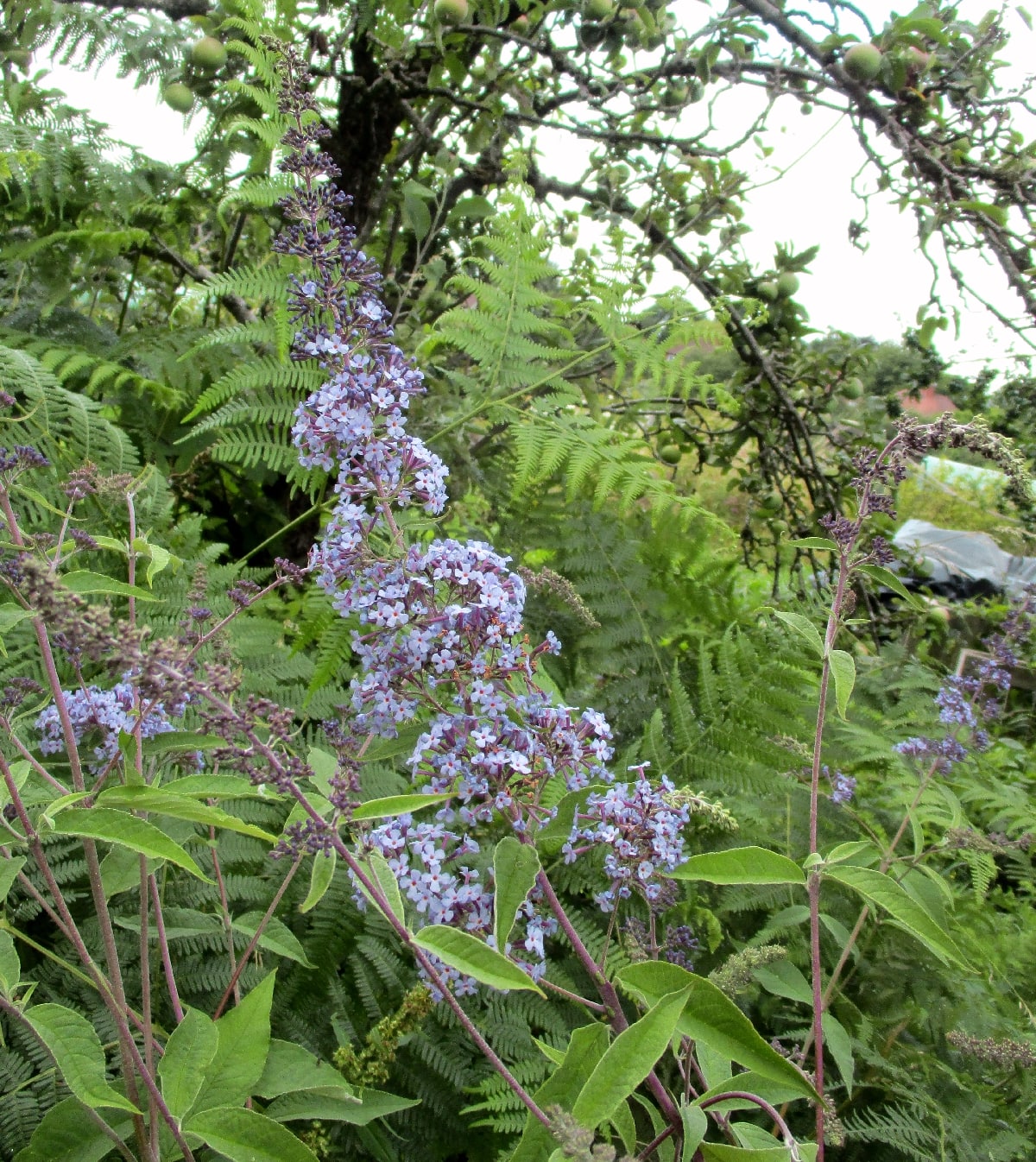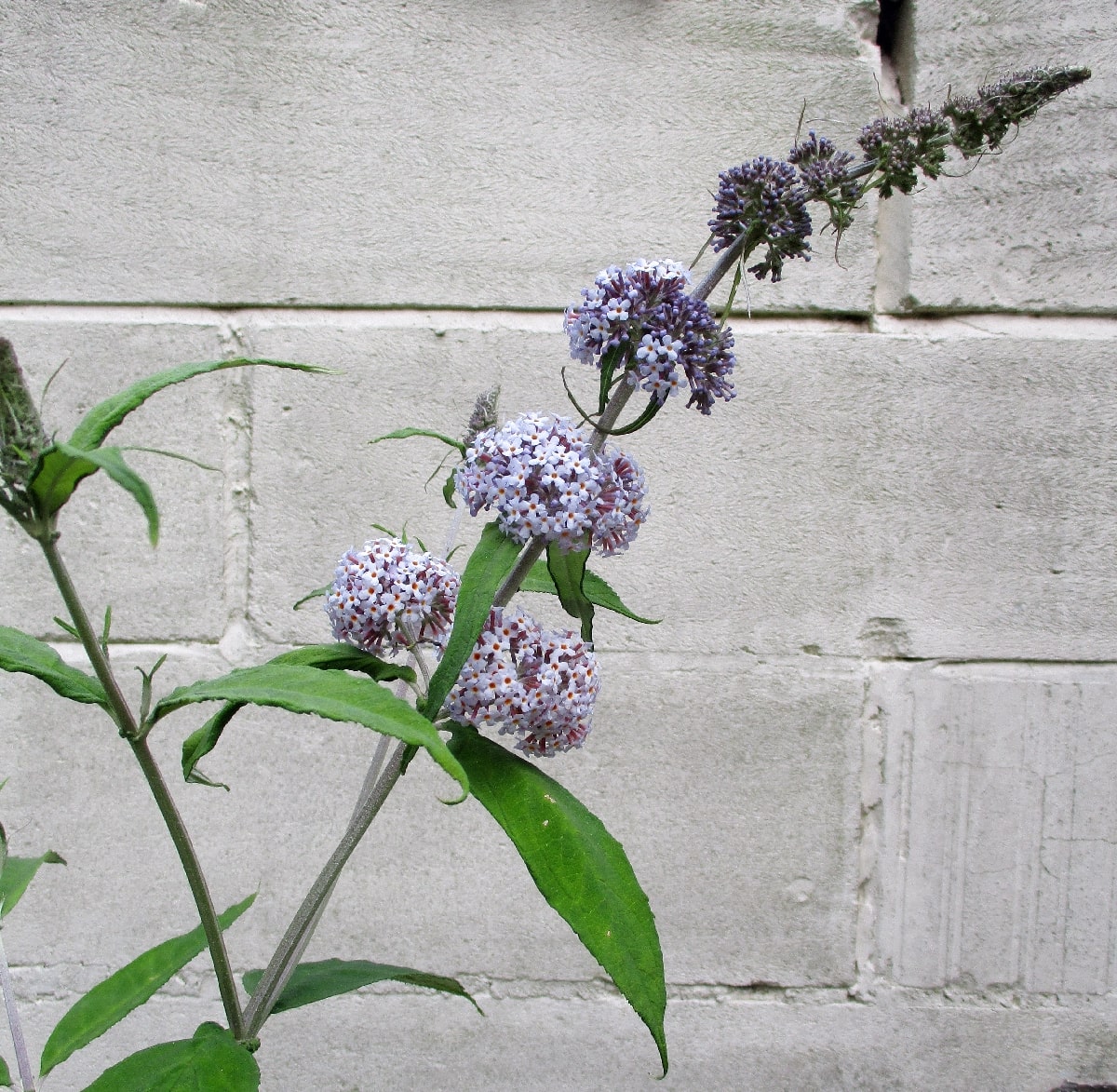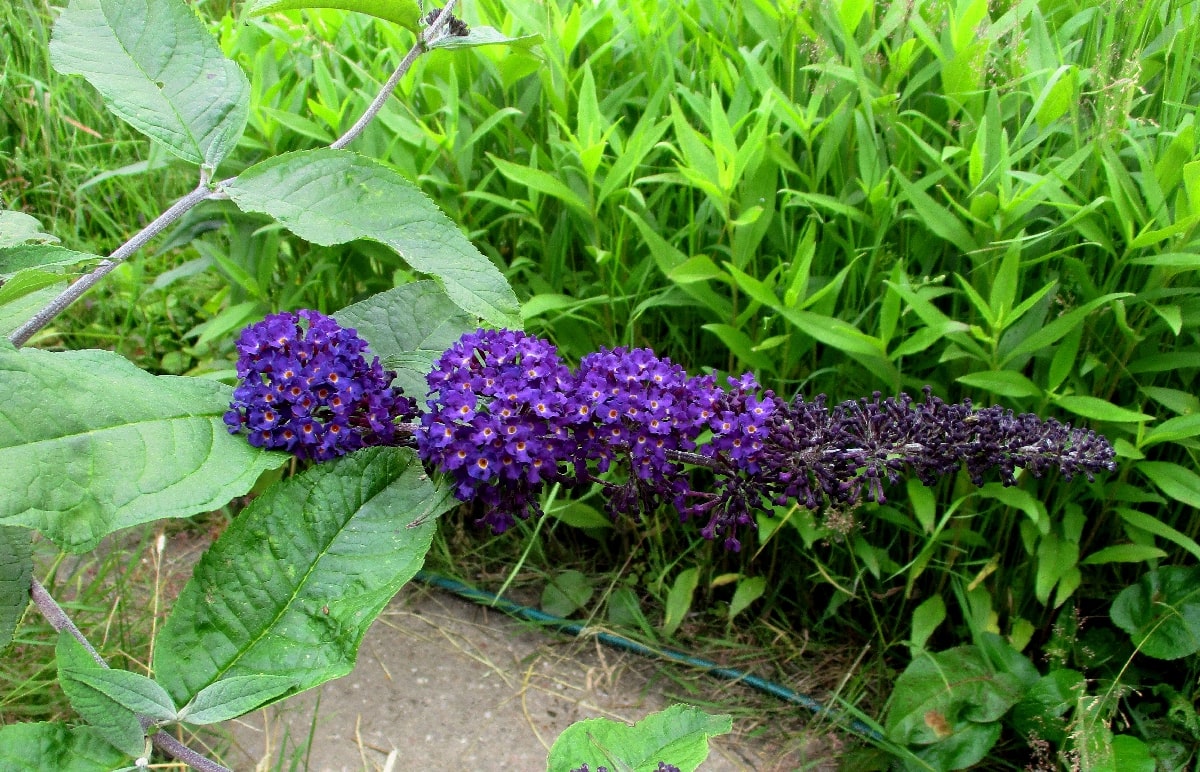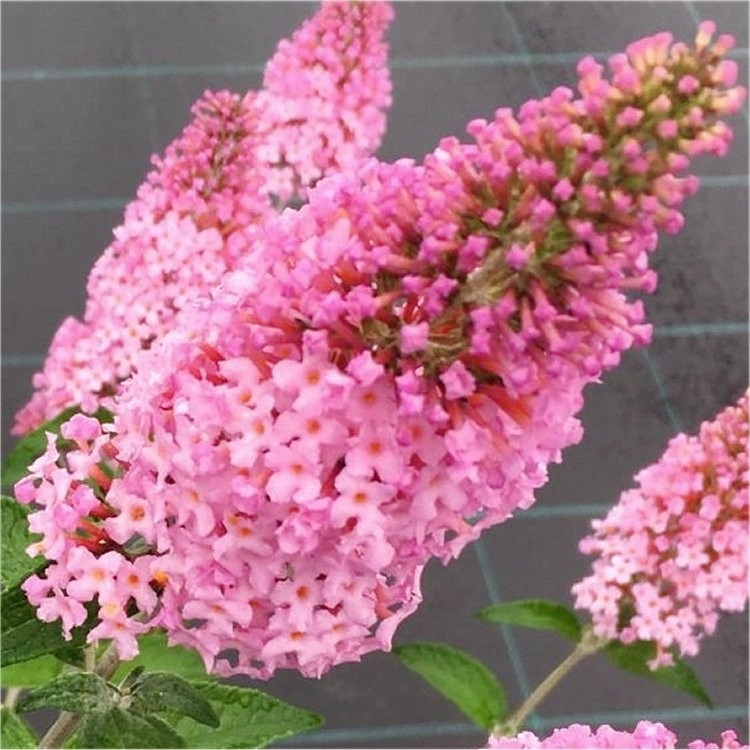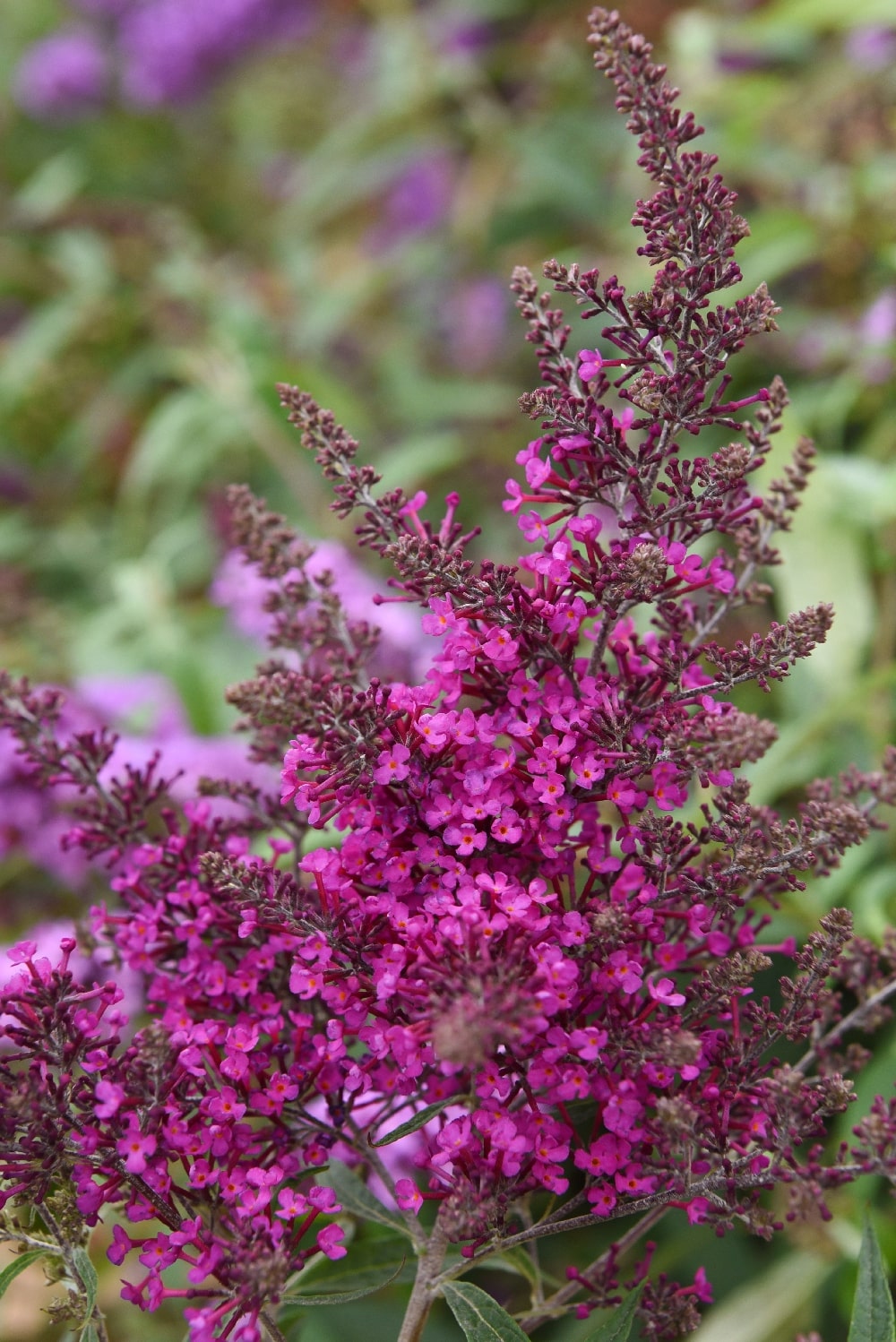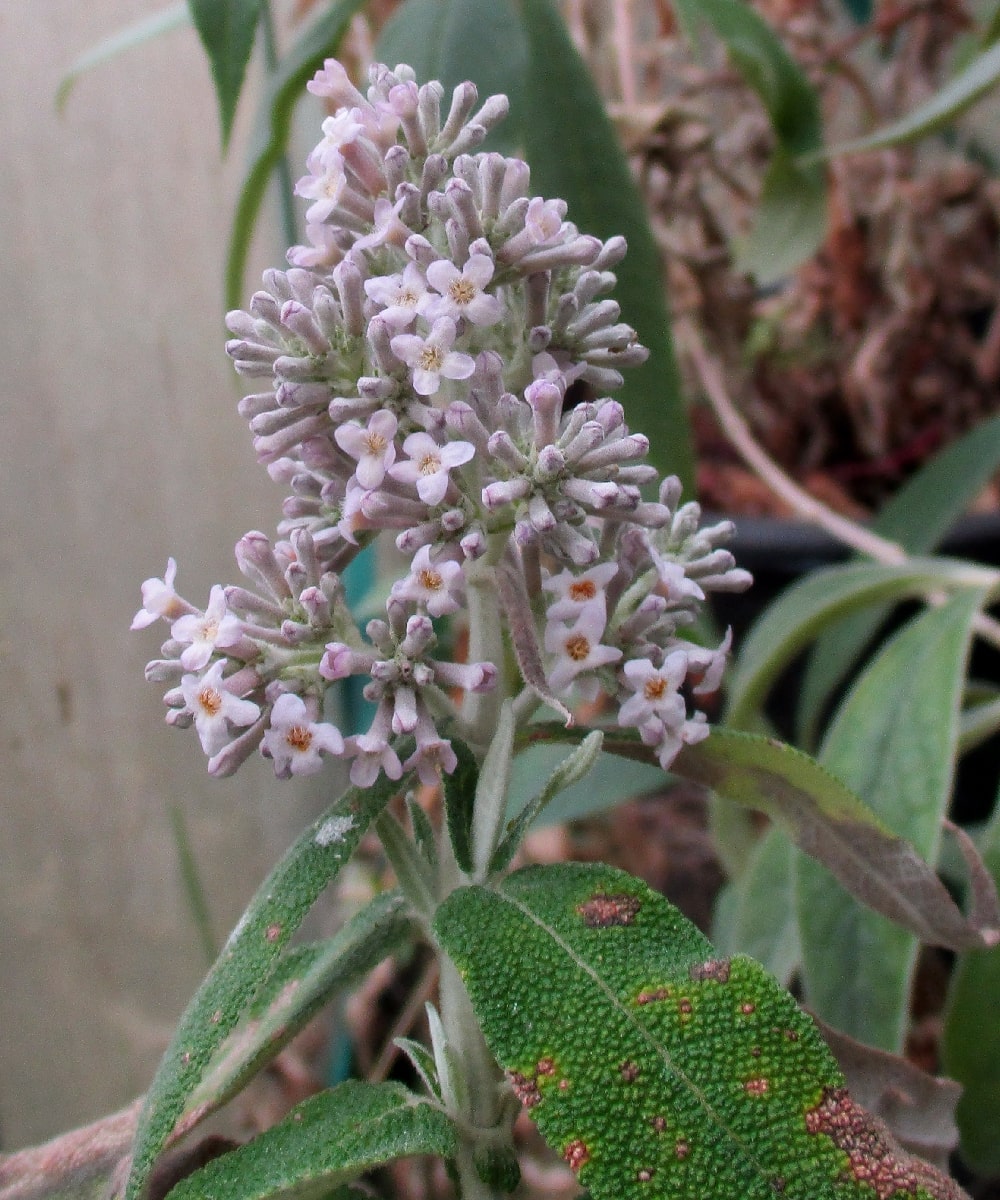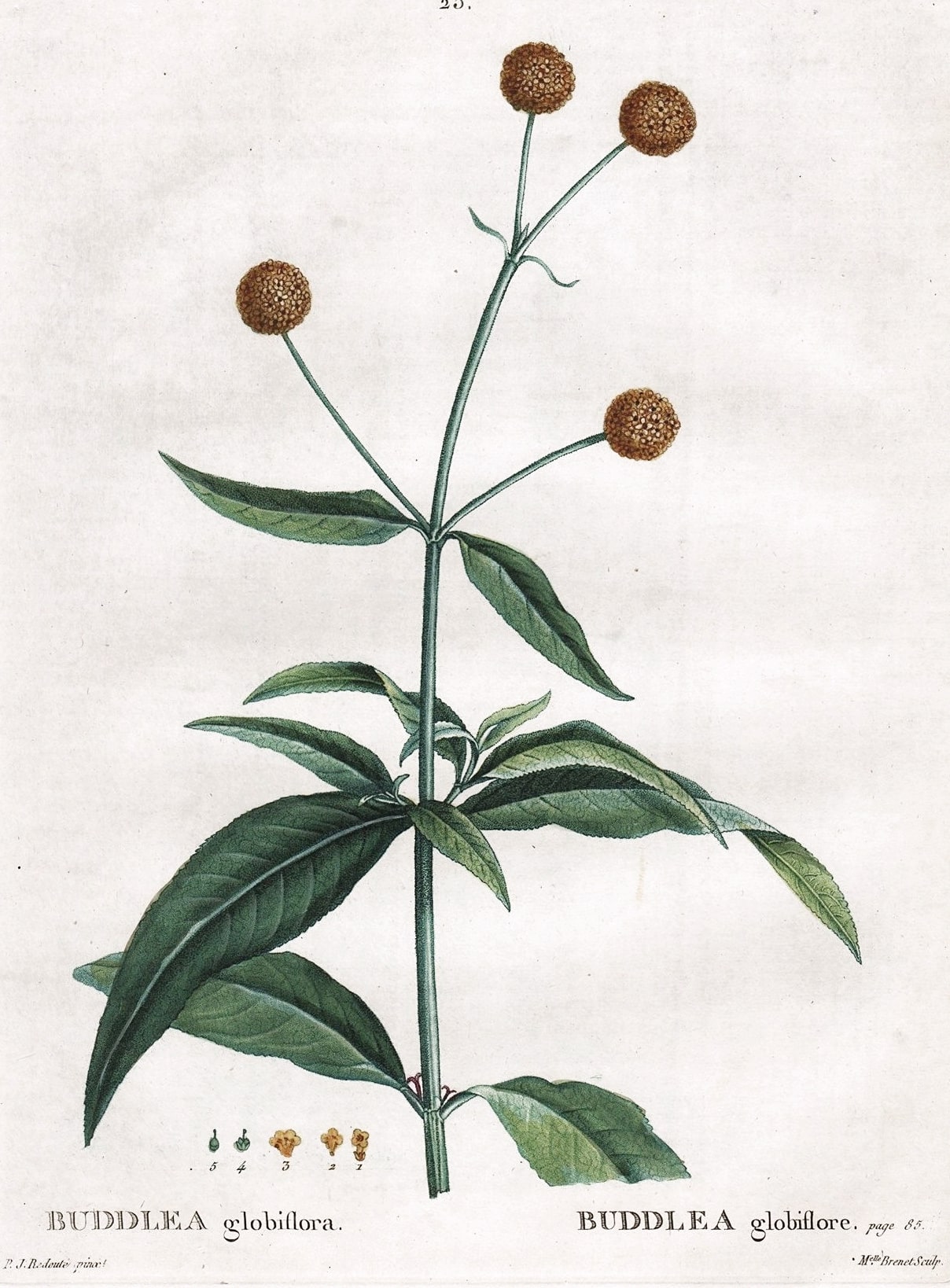
Buddleja 'Orange Sceptre'
16th October 2021
'Orange Sceptre' is a B. stachyoides X B.tubiflora hybrid, bred in America a few yeas ago. The parent species are both from South America and neither is particularly hardy. The hybrid is possibly a little hardier, maybe suitable for growing outside only in warm coastal areas and if given additional shelter. At the moment, I'm assuming it's not fully hardy in the Midlands of England.
I've grown several plants this year from seed. 'Orange Sceptre' has hermaphrodite flowers, which is much less common than dioecy in Buddleja species from the Americas. It's also is highly self-fertile and its F2 seedlings seem to be more or less true to type. It's possible subsequent generations will start to drift, possibly resembling one parent species more than the other. If I'm sucessful with this F2 generation, and it too proves self-fertile, I may grow an F3 and even an F4 cohort just to see if that happens.
A couple of my seedlings are flowering now under cover in their first year. They've been very fast-growing and have produced big felted and toothed leaves. The flowers are a brilliant orange shade, intermedaie between the parents - B. tubiflora flowers are a burnt orange and B. stachyoides is yellow flowered. 'Orange Sceptre' seems to be very vigorous, and is perhaps more like B. stachyoides in overall form.
It's been a bit of a race to get the flowers open before the Botrytis (Grey Mould) attacks the plants. Already one or two leaves are showing signs of this fuzzy mould, and I anticipate the plants will really suffer if we have a wet late autumn. I expect they'll survive in a cold greenhouse over winter, as I had a weedy seedling from last year that survived the winter - until the spidermites got at it in the spring; this year's seedlings are much healthier.
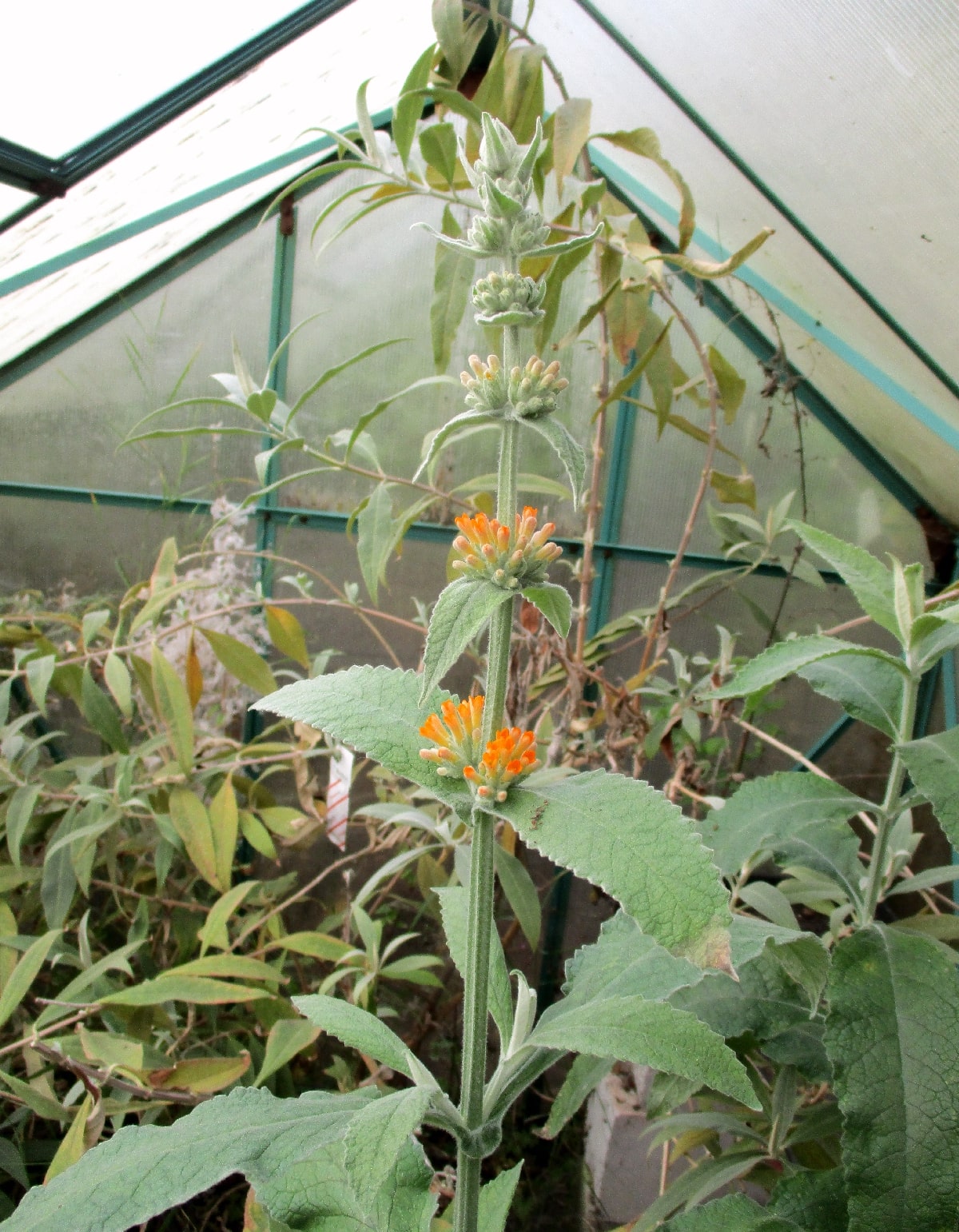
Buddleja 'Orange Sceptre'
Open full size image in a new window
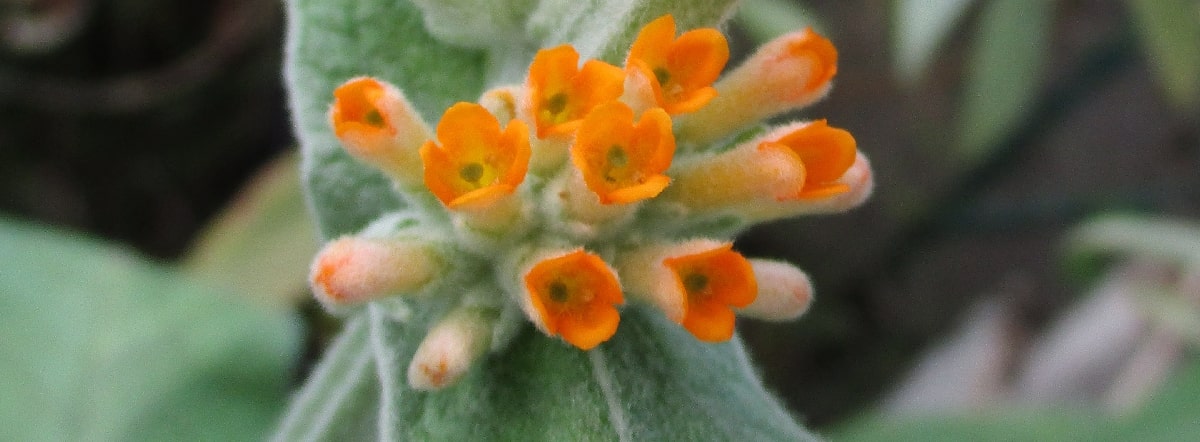
Close-up of the flowers
Open full size image in a new window
A Buddleja curviflora X Buddleja japonica Hybrid
8th September 2021
The more closely related the species, the more readily they will hybridise. Buddleja curviflora is very closely related to B. japonica, and they cross easily. Both are native to Japan. B. japonica is incredibly self-fertile and comes true from seed. The B. curviflora I used as the seed parent does not appear to be significantly self-fertile, so it's much easier to raise hybrids. As an aside, this particular B. curviflora is the plant carelessly mislabelled as B. myriantha in several collections.
Here is the result of the cross, a plant almost indistinguishable from B. curviflora. The stems are square and narrowly winged, a distinctive trait inherited from B. japonica. The foliage intermediate between the species and larger than either parent.
Both parent species share the same type of flower: long corolla tubes sharply curved in the middle (shown in the lower photo); petals are coloured variable shades of purple with a distinct white eye. The flowers of the hybrid are pretty typical for this group of Buddleja species (the Curviflorae).
This hybrid is not of any greater horticultural merit than its parents, and the hardiness is untested. I mostly grew it to demonstrate the very close relationship between Buddleja curviflora and B. japonica.
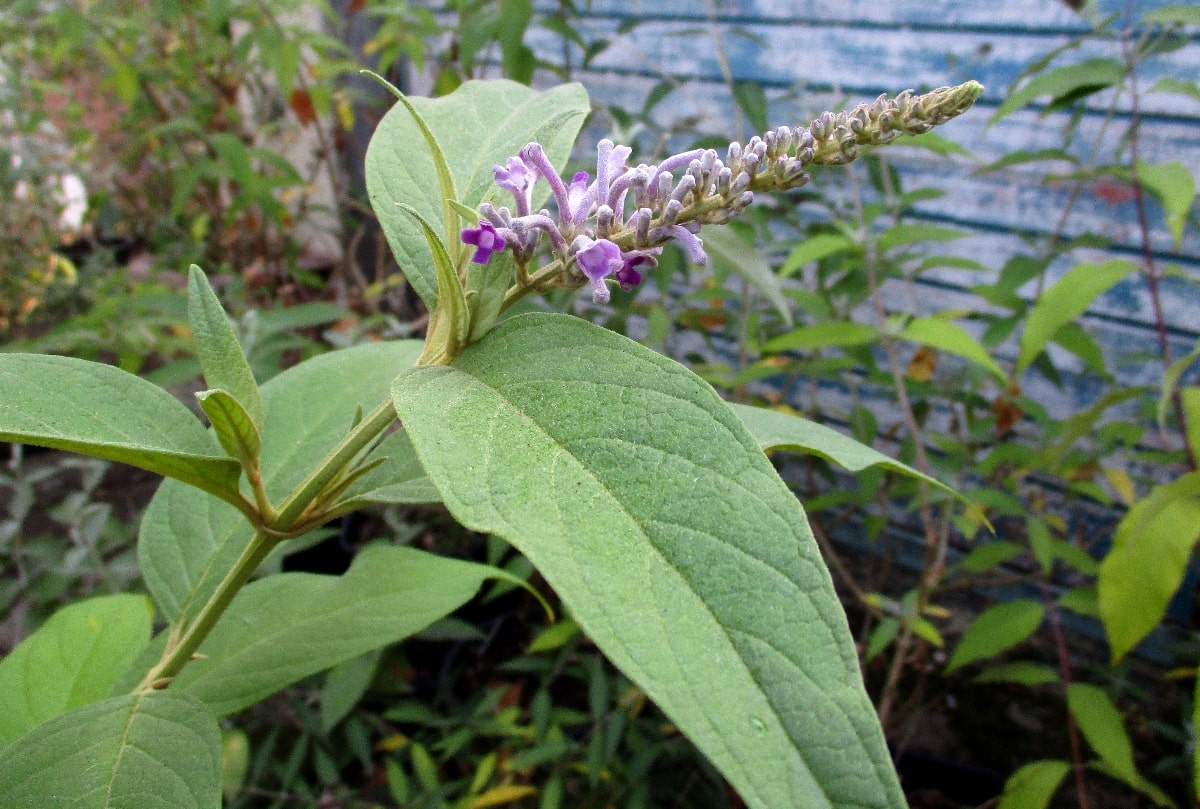
B. curviflora X B. japonica.
Open full size image in a new window
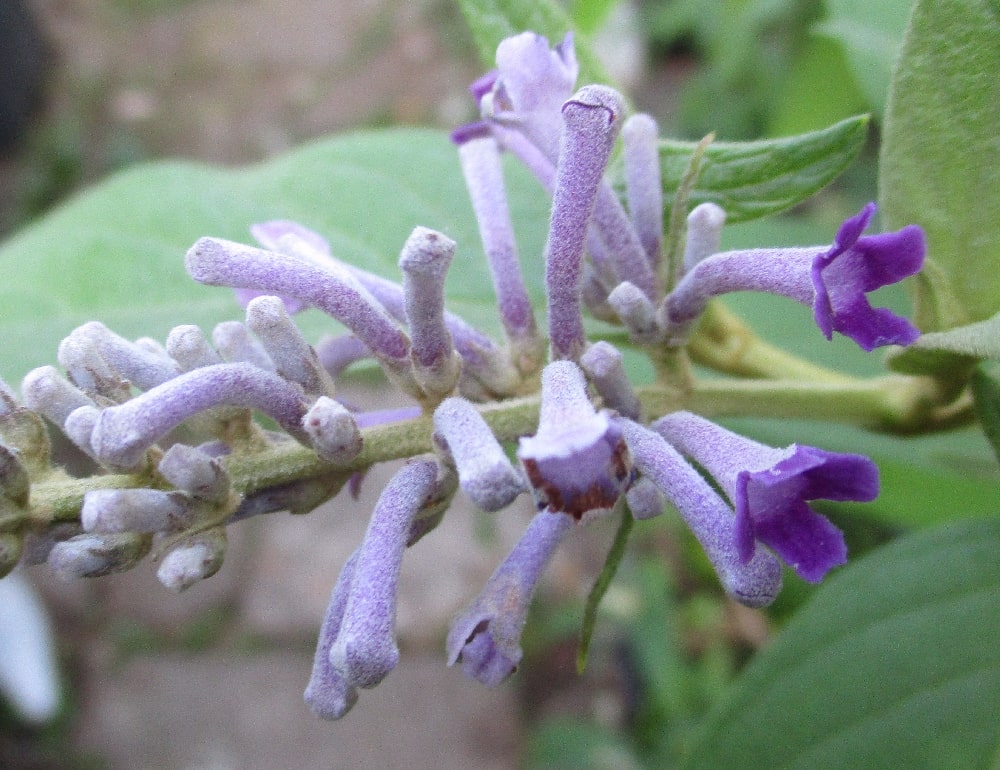
Close-up of the flowers.
Open full size image in a new window
'Pink Panther' - a new cultivar that might be worth trying
30th August 2021
'Pink Panther' is a new cultivar, and one I wanted to grow for myself. I received a small plant about a month ago, which already had flower buds forming. Now they've opened and the colour is superb, a delicate shell-pink and a true pink with almost no lilac. The shade is slightly different to the publicity photos (see below)
The inflorescence is fairly small at the moment, but I expect on the full-sized plant they'll be bigger. The blurb promises a compact shrub of about 1.5 m. This will be planted out in the spring, then we'll see exactly how it grows in a real garden situation.
The deluge of new plants continues: a new series called The Butterfly Candy Collection has just been launched in the Netherlands. This consists of Little Purple ('Botex 001'PBR), Lila Sweetheart ('Botex 002'PBR), Little White ('Botex 003'PBR), Little Lila ('Botex 004'PBR) and Little Ruby ('Botex 006'PBR). They look quite interesting in the publicity, especially Lila Sweetheart with its large yellow eyes. How they'll perform in a real garden is anyone's guess.
Buddleja forrestii type limitanea W/O 8046
14th August 2021
Buddleja forresttii is a varied species and, like B. macrostachya, is probably a species complex. One type of B. forrestii is also known as B. limitanea, which is a smaller and less vigorous form of the species.
The inflorescence shown is W/O 8046, from seed collected by Chinese Alpines on the Cangshan Mountain (Dali, Yunnan) at 3370 metres. The plant is going to be quite hardy coming from that altitude. Other B. forrestii (limitanea) collections also come from the same location - KR 2732, ACE 2522, BO 14-138 - so I assume this species-type is locally quite common. This one has darker flowers, a mauve-purple, whereas the others can be a paler colour or have a tendency to fade. An unusual feature of some of these plants is the pigmented calyx, and in the photo of W/O 8046 you can see this purple flush at the calyx's base.
Buddleja macrostachya - a home-grown seedling
11th August 2021
A couple of years ago I grew a number of seedlings of B. macrostachya RF 040 crossed with GWJ 9286. Both are described on my B. forrestii and macrostachya page; neither has been previously identified as B. macrostachya even though both are rather obviously that species. And they cross readily with each other in preference to anything else, producing seedlings broadly similar to themselves - good evidence for their both belonging to the same, single species.
Most of the seedlings were white or cream flowered, and had recognisable features from both parents (see here for more details). The one shown was an exception, unusual in having bright pink flowers, which are a little larger than either parent - 8-10 mm in diameter.
The first thought was that it might be a hybrid with another species, but I think this is unlikely - everything is perfectly in keeping with the parent species: the flowers have the typical long and cylindrical corolla tubes, the anthers are in the throat and the flower parts are tomentose. My second thought is that it may come from a self-pollination - even though I carefully hand pollinated using GWJ 9286, I didn't feel the need to emasculate the flowers as I believe RF 040 is not particularly self-fertile. However, I can see some contribution from GWJ 9286, although I can't completely reject the possibility of seedling being selfed.
The genetics of white flowers in Buddlejas are quite complex. These plants usually retain all the genes for producing the flower pigment (anthocyanin), but for various reasons they aren't fully expressed. This can be seen in many white-flowered B. forrestii and macrostachya plants where the buds have some pigmentation, which then fades away on opening. Whatever recombination has occurred in this instance has allowed the genes to be fully expressed, giving me the pink, summer-flowering B. macrostachya I've been looking for.
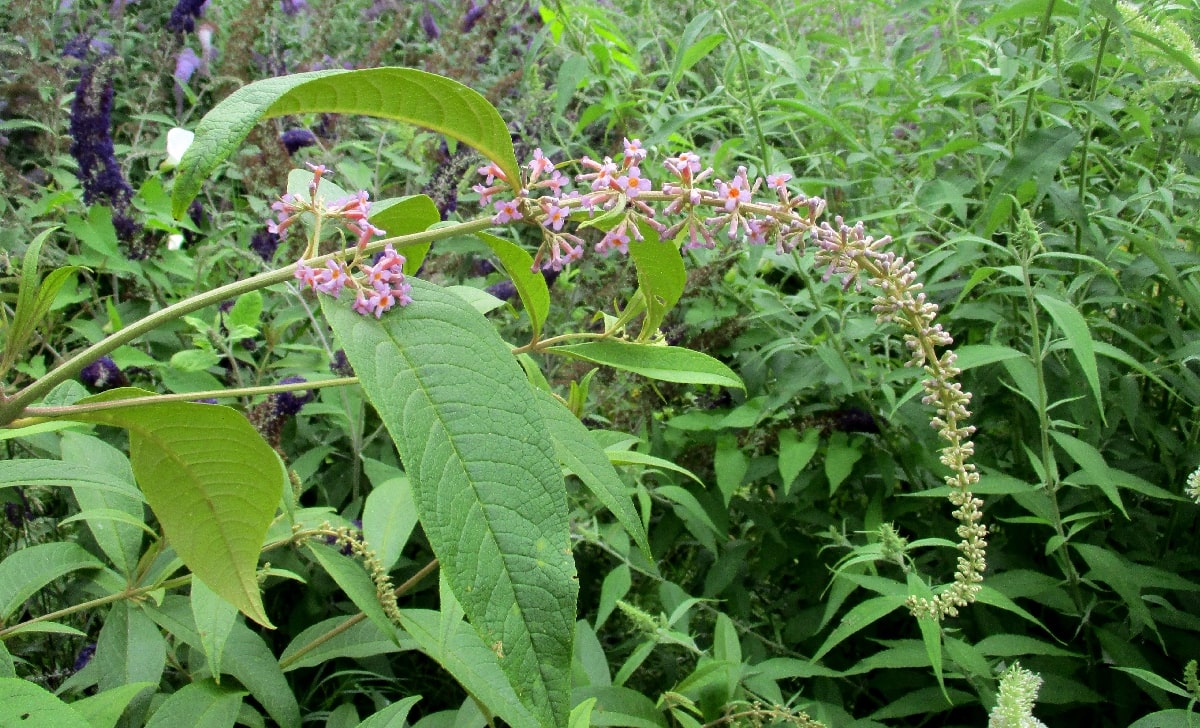
My B. macrostachya seedling has long pendulous panicles of pink flowers.
Open full size image in a new window
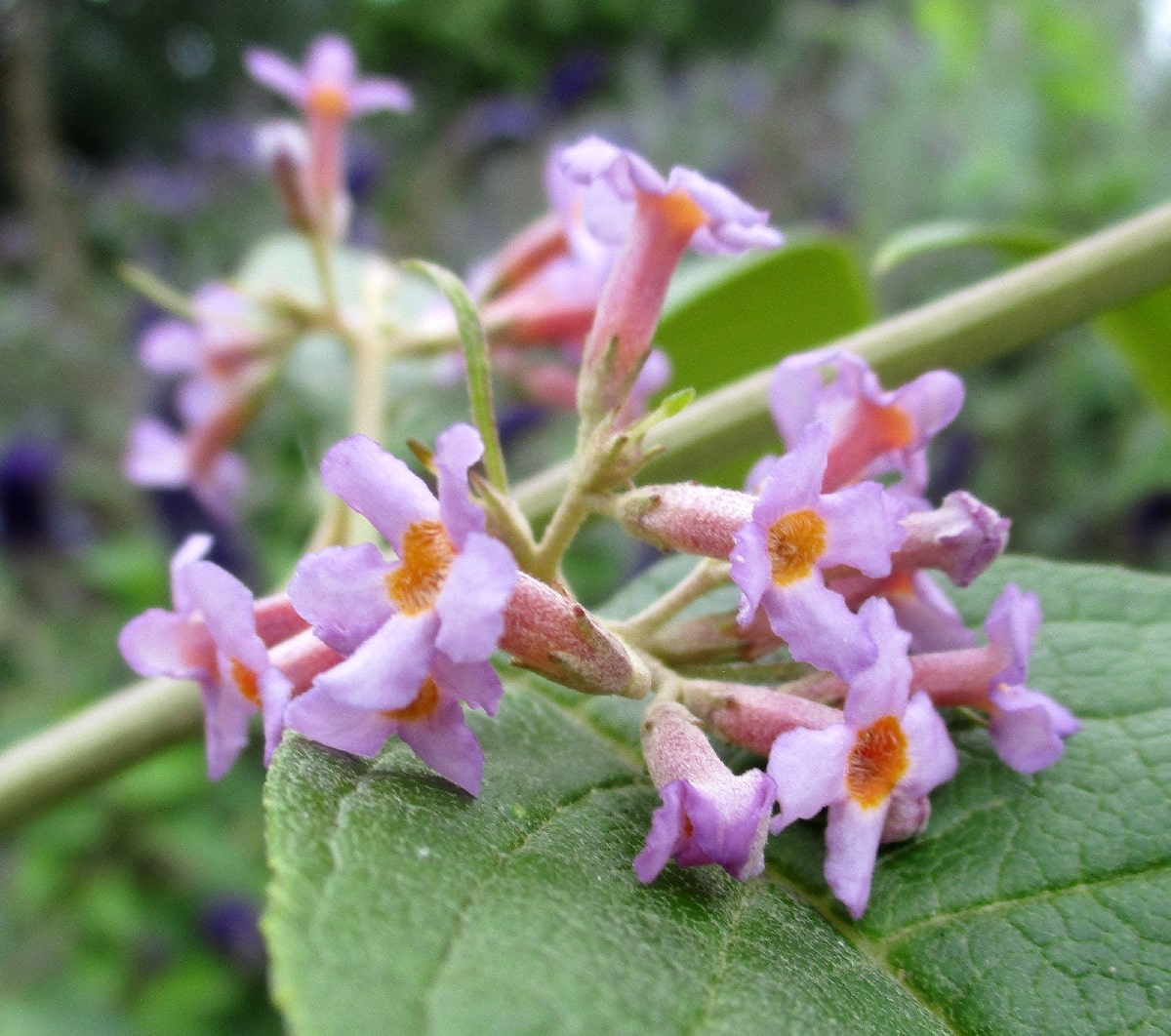
Up close you can see the cylindrial corolla tubes are covered in an indumentum, and that the flowers are typical of B. macrostachya.
Open full size image in a new window
Buddleja x alata
8th August 2021
One of the more mysterious Buddleja species or hybrids from Sichuan is Buddleja alata. Sadly, those labelled as such in cultivation have turned out on closer investigation to be B. macrostachya SBEC360. The description from Marquand 1930 suggests the original specimen is closely allied to B. myriantha. Leeuwenberg 1979 maintains it is in fact a hybrid of B. albiflora and B. nivea.
Without a living plant to examine, I decided to cross B. albiflora and B. nivea and see if I could recreate B. alata. Both species are very promiscuous, so I had plenty of viable seed to grow a few plants. The seedlings are all pretty much identical, intermediate with large hairy leaves and round furry stem stems. The individual flowers are a dirty lilac and tiny. It's very like the description for B. alata, except the stems are rounded rather than four-angled and narrowly winged.
B. myriantha is rare in cultivation - the plants sold as such are no such thing, but don't get me started on the mislabelling of Buddleja species. The example shown is W/O 8047 from Yunnan, China, which I grew from seed. The tiny individual flowers are only 3-4 mm in diameter, so it's not much of an ornamental - one for the enthusiast only.
The two plants are quite similar, except the B. nivea x B. albiflora hybrid has much denser hairs (stellate-tomentose) on every part of the plant including the flower-parts; also B. myriantha has four-angled, and not rounded, stems. The close up of the flowers shows how the hybrid has somewhat conical (infundibular) corolla tubes, compared to the more cylindrical tubes of B. myrianatha.
My hybrid might not correspond exactly to the description, but comparison with the Kew Herbarium specimen of B. alata shows it's fairly close.
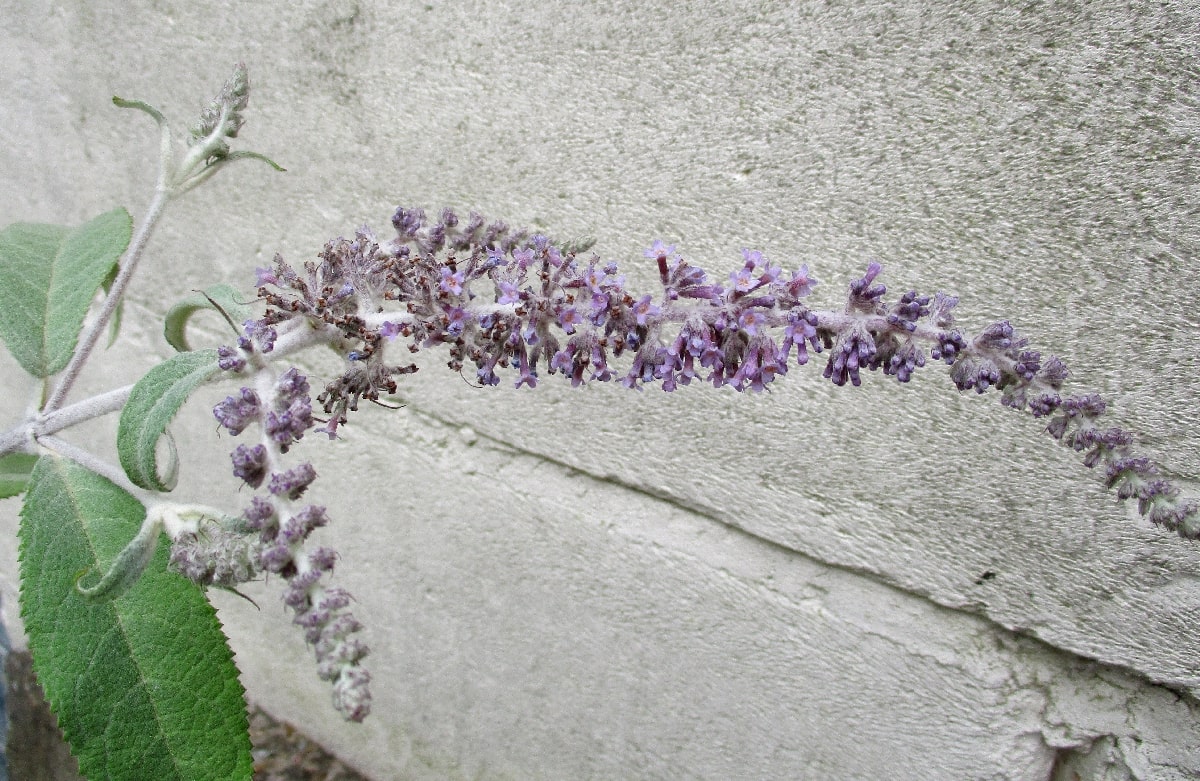
B. albiflora X B. nivea gives an idea of the appearance of B. alata.
Open full size image in a new window
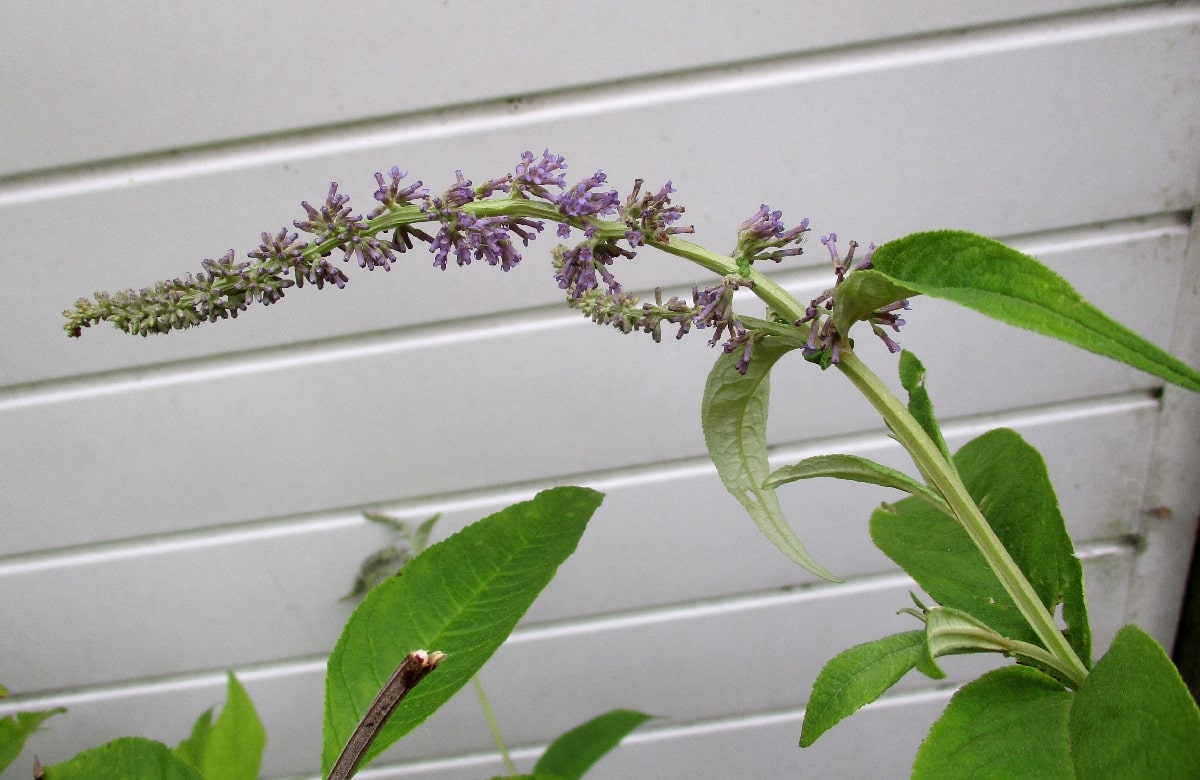
B. myriantha has tiny flowers like the hybrid, but can easily be distinguished.
Open full size image in a new window
Buddleja 'Glasnevin Hybrid'
5th August 2021
'Glasnevin Hybrid' has taken me a while to establish fully, as it's a little delicate. This is a restrained, smaller Buddleja with narrow grey foliage. The flowers, which are a pale lavender blue, have been excellent this year.
This cultivar is named after the location of the National Botanic Gardens of Ireland (Glasnevin in County Dublin), where it is believed to have originated some time prior to 1952. Some sources incorrectly describe 'Glasnevin Hybrid' as a hybrid of B. fallowiana and B. davidii from Lochinch Castle, Scotland, which makes no sense whatsoever given the name. More likely, it's actually a hybrid of B. davidii var. nanhoensis.
Buddleja davidii
from Sichuan
30th July 2021
Philip Larkin famously said: 'I wouldn't mind seeing China if I could come back the same day.' Not sure I quite share the sentiment, and it might be interesting to see Buddleja in their native habitat. For now though, I'll content myself with growing wild-collected specimens on my own plot.
B. davidii H&M (Howick and McNamara) 1402 was collected in 1990 from east of Xichang in South Sichuan, at an altitude of 2720m. Plants from this altitude are usually fully hardy in England, even though Sichuan is at a significantly lower latitude. The flowers are a very pale lilac-lavender, and the inflorescence has larger bracts than average. Otherwise, it's pretty typical for the species.
My thanks to Royal Botanic Gardens Edinburgh for the plant material.
Buddleja davidii
Very Pink
28th July 2021
Before cultivars like 'Sugar Plum' and 'Miss Ruby' increased the palette of Buddleja hues, there were already two stunning deep pink cultivars - however, both come with issues. 'Pink Spread' has fine pink-red flowers and a terrible growth habit, sparse and spreading; worse still, it doesn't regenerate well from the base, leaving a significant portion of the old wood visible. 'Summer Beauty' is a neat plant with bright cerise-pink flowers, but is hard to propagate and difficult to establish; the flowers can also turn somewhat mauve as they fade.
Considering how both 'Pink Spread' and 'Summer Beauty' have disadvantages, it might be a mistake to use them to breed new cultivars. I have to admit that all the 'Summer Beauty' seedlings I've raised have wound up on the compost heap. On the other hand, a few 'Pink Spread' progeny have been rather good.
The one shown is from a cross with 'Summer Beauty', so it could potentially have inherited the bad habits of both. Indeed, all of its siblings were rejects. This one stood out: a good colour and a respectable growth habit. The flowers are a reddish pink, and become a mosaic of lighter and darker shades as they fade. And the panicle is large and airy. It propagates easily and has reasonable vigour without becoming unruly.
I don't think it's perfect, not yet. More of a work in progress, and I'm looking for a suitable partner to produce another generation.
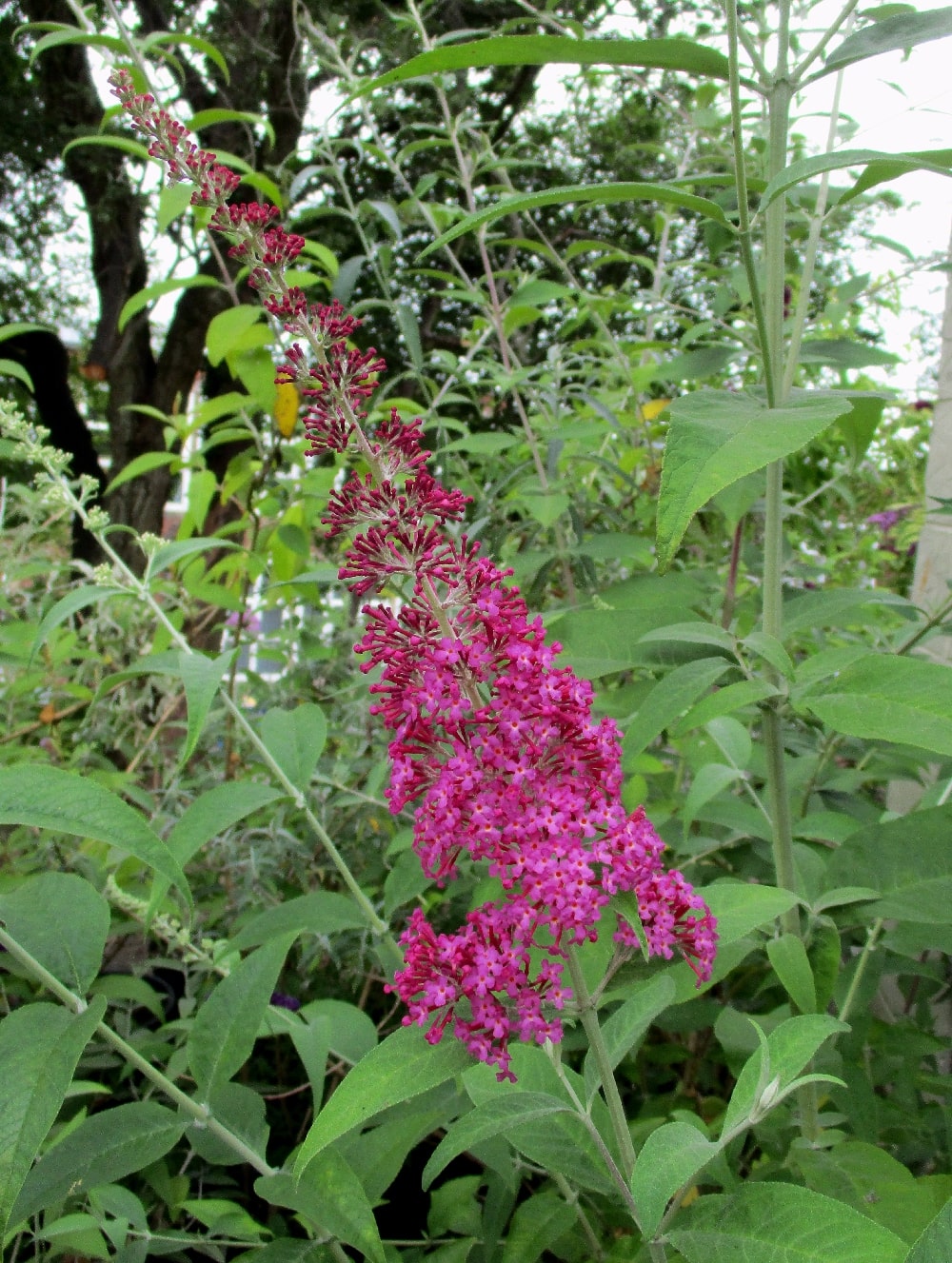
This Buddleja davidii seedling is an improvement on both its parents.
Open full size image in a new window
Buddleja forrestii
type: pterocaulis
20th July 2021
The Victorian and Edwardian plant hunters often named plants they thought were new, but were in fact simply different examples of a previously described species. Failing this, they might name a new sub-species of an existing species based on infinitesimal differences. Many of these names are now redundant, and the current taxonomy recognises fewer Asian Buddleja species and subspecies than in the past. Having said that, sometimes a species might be better described as a species aggregate or species complex, because there is a high degree of infra-specific variability; this could be a sign of ongoing or incipient speciation.
Buddleja species can be particularly tricky - they hybridise easily; conversely, they can be highly self-fertile; they often have large genomes carrying recessive traits which seem to pop-up from nowhere in later generations.
This is a B. forrestii with a number of names. It was first known as B. longifolia, before being renamed B. pterocaulis. Then the species was sunk under B. forrestii.
After several years and letting it take over half my greenhouse, it has finally flowered, and a rather pathetic tiny panicle it is too. Still, it's enough to identify the species accurately.
Clearly, this is a form of B. forrestii, and pretty much typical for that species. The literature suggests the flowers are usually violet, but these have opened white. The individual flowers conform exactly to the species description for B. forrestii. Using a magnifier, you can see the exterior of the corolla and calyx are glabrous (almost hairless) and the corolla tube flares towards the mouth. The interior of the flower is pilose (fewer silky hairs), with the stigma almost level with the stamens. When dissected from the rest of the flower, it is obvious that the ovary is also glabrous.
Based on these very typical features, I have no idea why this was ever accepted as a discrete species.
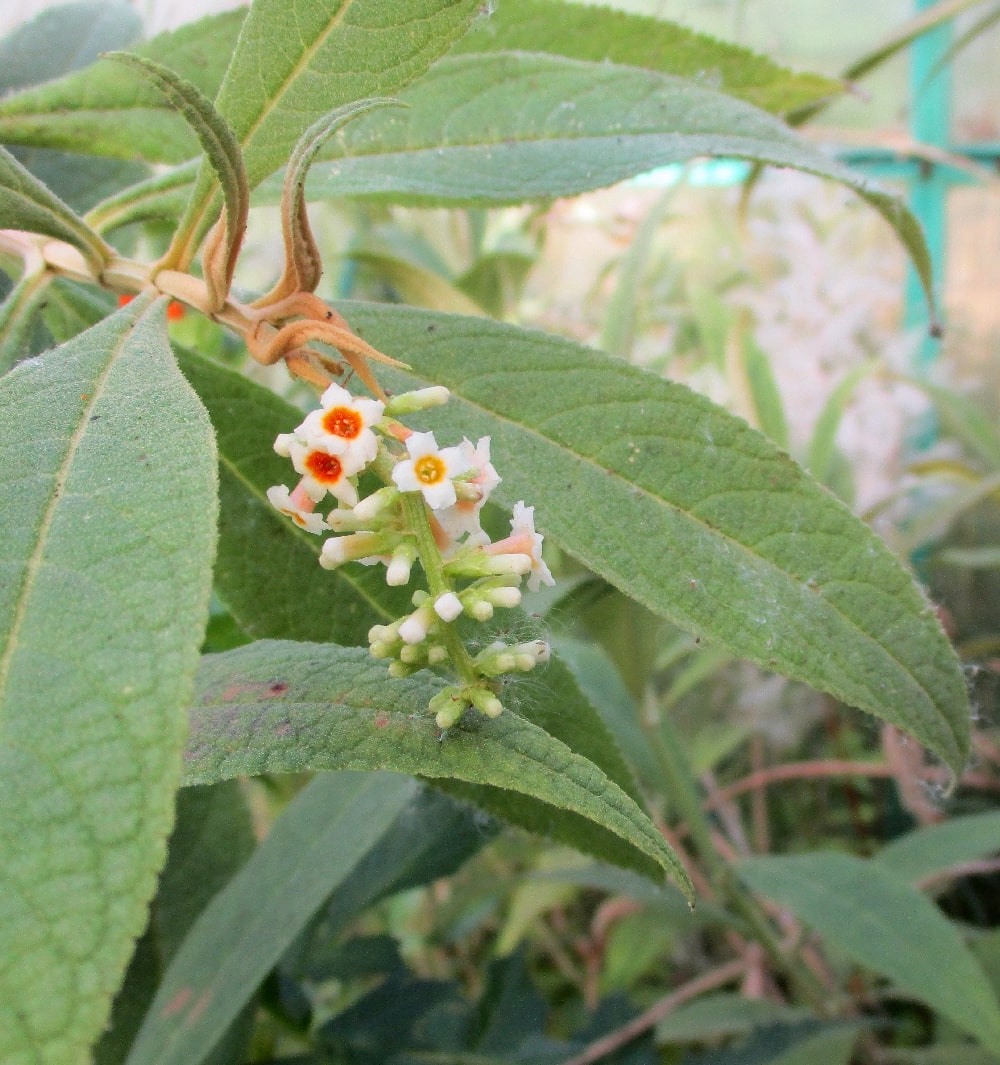
Buddleja forrestii (pterocaulis)
Open full size image in a new window
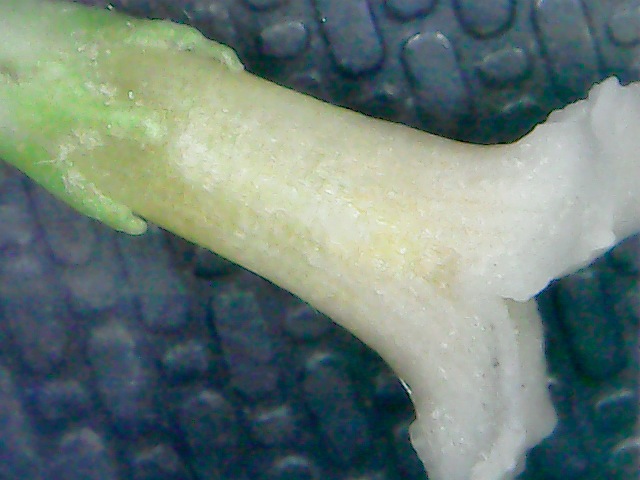
Buddleja forrestii (pterocaulis) - exterior of the flower.
Buddleja davidii
'Midnight Skies'
7th July 2021
I came across a plant called 'Midnight Skies' in a local garden centre. Available via Lowaters Nursery (Hampshire), I believe this plant was originally bred by Peter Moore (Longstock Nursery and National Buddleja Collection). A more traditional Buddleja davidii cultivar of normal proportions, its flowers are a good purple colour, although not quite a shade I would call midnight. A common feature of these darker colours is a paler, sometimes almost white, ring around the orange eye; even 'Black Knight' shows this tendency. Were this fading centre to be absent, the flowers might appear really dark.
Another New Cultivar:
Buddleja 'Pink Panther'
19th June 2021
The number of Buddleja cultivars must have doubled over the last decade. And here is another to add to the list - 'Pink Panther' ('RuttenBU2016'), a selection by Pierre Rutten in France. This one promises to remain compact at less than 1.5 metres in height and a smaller spread. The flowers should be large for such a small cultivar and of a bright true pink. Many pinks are more like a lilac colour or else too brash, and I'm very interested to see the exact shade of this 'Pink Panther'.
With so many new plants on the market, 'Pink Panther' will have some stiff competition from other pink cultivars like Buzz 'Candy Pink', but it looks quite promising.
'Pink Panther' is available from Gardening Express. Photo courtesy of Gardening Express.
New Cultivar from T&M:
Buddleja 'Octopus'
2nd June 2021
The output of new Buddleja varieties seems to continue unabated. This one is something a little different from Thompson and Morgan - a plant similar to the successful Buzz series, but with highly branched flowers. Buddleja 'Octopus' has a branching habit and is compact, reeacing only about 120cm in height. The multiple flower panicles are rather like 'Dartmoor' or 'Camberwell Beauty'. I'm not sure each flower-spike has eight limbs, and it looks like there's possibly a higher number of flower-branches.
The flower colour is advertised as magenta, and I'm interested to see actual shade when I start growing this cultivar, to see whether it is brighter than the rather dull 'Camberwell Beauty'. It should be quite showy and promises a longer flowering period.
I believe 'Octopus' and its siblings were code-named Buzz2 when being developed by Thompson and Morgan's own breeding programme (now defunct), and possibly others with different coloured flowers will appear in subsequent years.
'Octopus' is available from Thompson and Morgan.
Photo courtesy of Thompson and Morgan's Press Office.
Buddleja salviifolia Lilac-form
29th March 2021
The blue-flowered form of the African species B. salviifolia, which has felted sage-green leaves, is the most familiar to horticulturalists. There is also an 'Alba' or white-flowered form in the trade with slightly different foliage, still sage-like but the leaves are longer and with a more ruckled (bullate) upper surface. Neither is necessarily typical for the species in its native range.
I was able to obtain some seeds from South Africa (Silverhill Seeds) and grow a handful of seedlings. Their foliage is more like the 'Alba' type, perhaps not quite so long. One seedling has flowered and it's a pale lilac. That's something I've been wanting for a couple of years. With lilac-flowered specimens all but absent from nurseries and collections in the UK, I'm rather fortunate to have found one in a tiny packet of seeds. Although South African websites suggest this colour flower is very common, if not the most common, for this species, so perhaps it's not luck after all.
The blue and white ones have proven reasonably hardy and I'm hoping this one too can take the frosts.
Buddleja globosa and Buddleja araucana update
25th March 2021
Everything seems slow to get going this spring, and it can be a risk to start pruning, repotting or planting out before the Buddlejas have responded to the longer days.
So I've had a chance to look at some of the old pages and start the process of updating. The Buddleja globosa and Buddleja araucana page was looking a little tired and I had some new information to add. The new version is up now, with better photos and a new format.
B. globosa was actually the first Buddleja grown as an ornamental in England, introduced by the Vineyard Nursery in Hammersmith, way back in the late 18th century; that's a hundred years before B. davidii was introduced into gardens. The illustration is by the renowned French botanical artist Pierre-Joseph Redouté, and dates from an 1809 edition of Henri Louis Duhamel de Monceau's Nouveau Duhamel, ou Traité des arbres et arbustes que l'on cultive en France, showing the species was already being widely cultivated in France by this date.
New Article:
Buddleja forrestii and
Buddleja macrostachya
Posted 13th March 2021
There is a new page on The Buddleja Garden. I've accrued a lot of information on Buddleja forrestii and Buddleja macrostachya, so I thought it was time to give these two species their own page. There are plenty of photos of specimen plants, so many I've included an additional gallery of those I couldn't fit onto a single page. The two are very similar: there's plenty of detail on how to tell them apart.
See the B. forrestii and B. macrostachya Page.
Growing a number of different plants of each species has been quite instructive. I've been able to tear flowers apart and look at them closely, something you can't really do when visiting other people's gardens or botanical collections. I've grown some seedlings from my plants, and included some of the resulting hybrids on a Supplementary Gallery page.
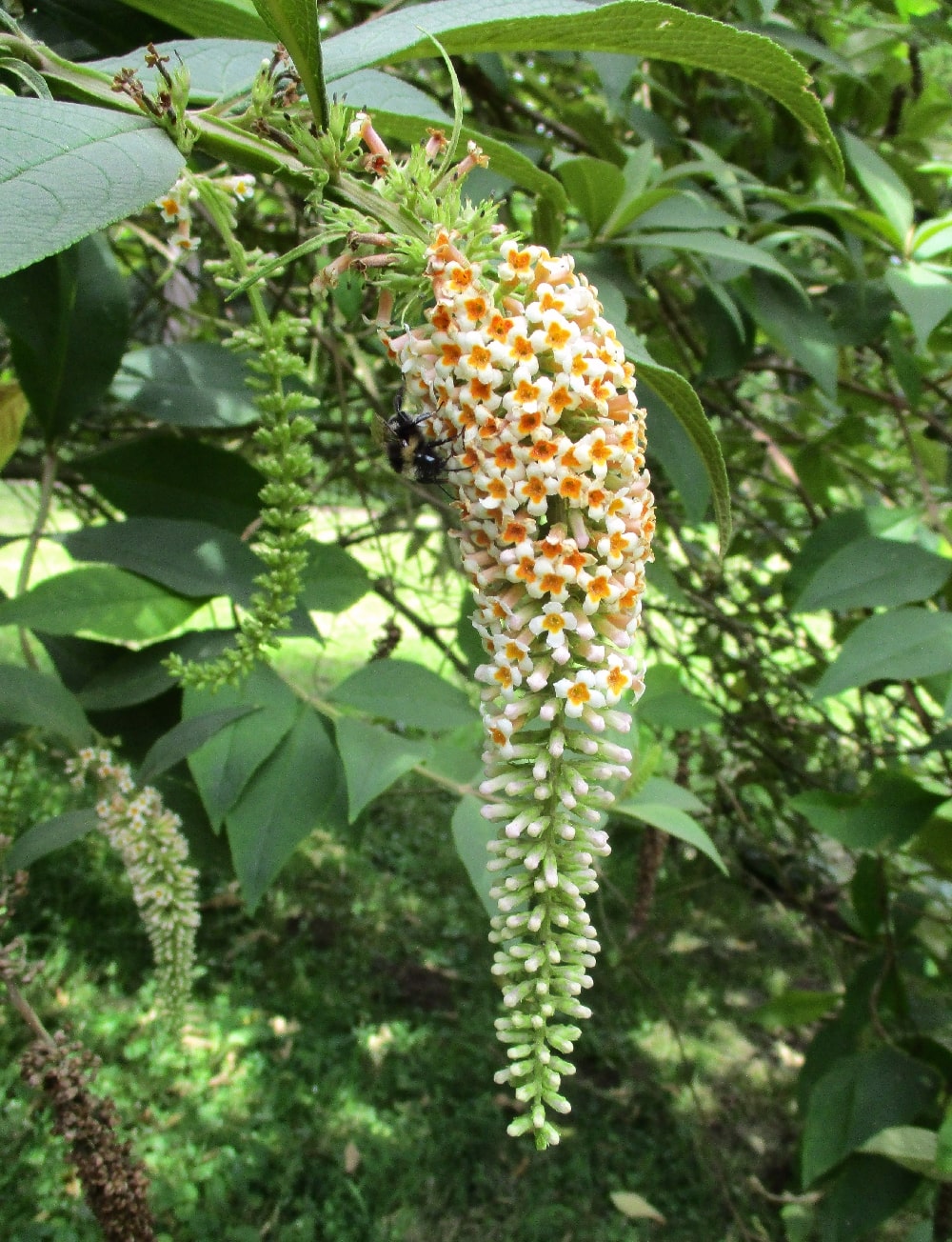
Buddleja macrostachya SBEC 360
Open full size image in a new window
New Year - New Look
Posted 8th February 2021
Another new look for The Buddleja Garden Diary. The page is now 'responsive', which means it should automatically adjust for small screens on phones and tablets. I've tried to keep the appearance much as it was before: simple, uncluttered, and concentrating primarily on the content. The top-menu is new.
Later, I hope to convert more pages to be responsive without changing the layout for desktop viewing.
In the meantime, here is my favourite antique illustration of Buddleja colvilei, which should change size with the window.
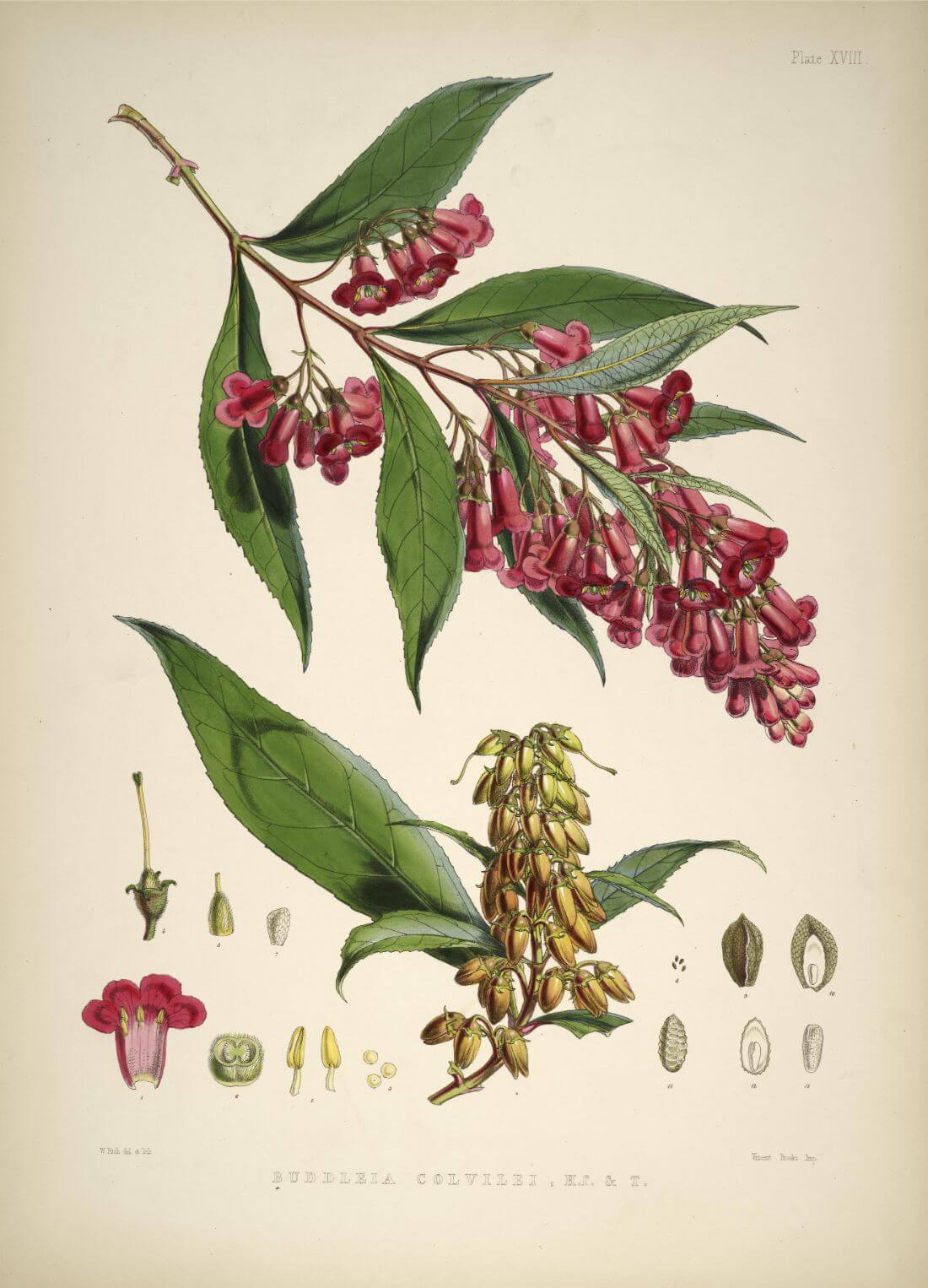
Buddleja colvilei
Open full size image in a new window.
Email:
buddlejagarden@gmail.com
© The Buddleja Garden 2011-2025.
